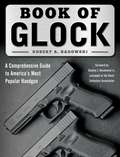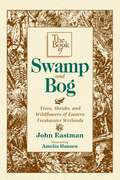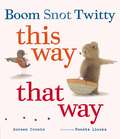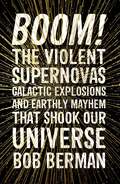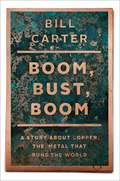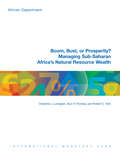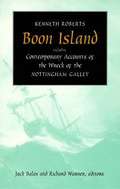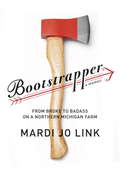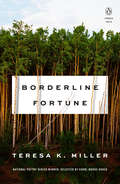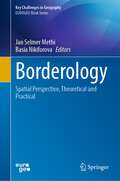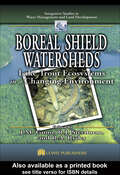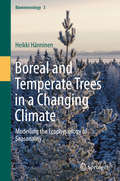- Table View
- List View
Book of Glock, Second Edition: A Comprehensive Guide to America's Most Popular Handgun
by Robert A. Sadowski Stanley J. Ruselowski Jr.In this fully updated and revised edition, Robert A. Sadowski showcases all of Glock&’s handgun models, from the first model, the Glock 17, which premiered in 1982, to the latest models, and educates firearms enthusiasts on the history, features, and specifications of each model.Book of Glock references all Glock pistols available in the United States with in-depth information on all models—history, serial numbers and letter prefixes, rare Glock variants, conceal carry models, cutaway sales models, and more. Sadowski worked closely with Stanley Ruselowski Jr., the president of the Glock Collectors Association, to bring readers information and photos of rarely seen Glocks. Each chapter is dedicated to a different model. Sadowski provides a timeline of the company&’s evolution and a close look at how Glock redefined the combat pistol. Other chapters touch on rare models, commemorative editions, and Glock tools and accessories. Whether a firearms collector or a new enthusiast, anyone can enjoy Sadowski&’s analysis of Glocks throughout history.
Book of Glock: A Comprehensive Guide to America's Most Popular Handgun
by Robert A. Sadowski Stanley J. RuselowskiWhile movies and television have made many people familiar with the name Glock, not many know the history of Glock’s pistols. With The Book of Glock, Robert A. Sadowski showcases all of Glock’s American handgun models, from the first model, the Glock 17, which premiered in 1982, to the all-new G43, and educates firearms enthusiasts on the quirks of each. The Book of Glock references all Glock pistols available in the United States with in-depth information on all models—history, serial numbers, rare Glock variants, comparative models, cutaway sales models, and more. Sadowski worked closely with Stanley Ruselowski, the president of the Glock Collectors Association, to bring readers information and photos of rarely seen Glocks. Each chapter is dedicated to a different model. Sadowski provides a timeline of the company’s evolution and a close look at how Glock redefined the combat pistol. Other chapters touch on rare models, commemorative editions, and Glock tools and accessories. Whether a firearms collector or a new enthusiast, anyone can enjoy Sadowski’s analysis of Glocks throughout history.
Book of Nature Projects
by Elizabeth LawlorFun and informative activities for all ages. A handy collection for any season of the year.
Book of Swamp & Bog
by John EastmanEcological approach to natural history provides complete descriptions of 80 common wetland plants.
Book of the Black Bass: Comprising Its Complete Scientific And Life History Together With A Practical Treatise On Angling And Fly Fishing And A Full D
by James A. HenshallBook of the Black Bass by mid-western medical doctor and author, James A. Henshall, details the complete scientific and life history of the black bass, a genus of freshwater fish in the sunfish family (family Centrarchidae) of order Perciformes. Sometimes erroneously called black trout—the name ‘trout’ more correctly refers to certain members of the salmon family—the black bass are distributed throughout a large area east of the Rocky Mountains in North America, from the Hudson Bay basin in Canada to northeastern Mexico. Black bass of all species are highly sought-after game fish, and bass fishing is an extremely popular sport throughout the bass’s native range.Complete with a practical treatise on angling and fly fishing and a full description of tools, tackle and implements, Book of the Bass is a remarkable work of angling and fly fishing literature on the subject of Black Bass that will appeal anyone “with an interest in a fish that has never been so fully appreciated as its merits deserve.”This edition is the 1904 revised edition, which contains much of the writings in Henshall’s 1889 follow-up, More About the Black Bass.Wonderfully illustrated throughout.“James A. Henshall’s name will always be associated with the Black Bass. Not alone is the sportsman indebted to him, but the ichthyologist as well for the knowledge of this fish.... In a masterly manner the author gives the fullest instruction concerning tools, tackle and implements to be used in black bass fishing, and at the conclusion there is to be read a chapter on fly fishing in its broadest sense.”—The New York Times, 1904
Boom Snot Twitty
by Doreen CroninBoom!Snot…Twitty?Three unlikely friends,and three different waysof being in the world.This simplest of storiesis a fable for life.
Boom Snot Twitty This Way That Way
by Doreen CroninThe perfect spot is this way! says Boom.The perfect spot is that way!” tweets Twitty.Snot is smartly silent.How will these three friends decide which way to go to find the perfect spot?With humor, wisdom, and perfect storytelling and illustrating pitch, New York Times bestsellers Doreen Cronin and Renata Liwska present a tale of authentic friendship.
Boom!
by Howard GutnerShort book about volcanoes. It describes how volcanoes are created and what they do. Illustrations are described.
Boom!: The Violent Supernovas, Galactic Explosions, and Earthly Mayhem that Shook our Universe
by Bob BermanLooking at the night sky, you&’d be forgiven for thinking it&’s all quiet up there in space. But you&’d be wrong. Extreme events are forever unfolding: galaxies explode, cosmic debris hurtles through the heavens and our own Milky Way is on a collision course with the giant Andromeda galaxy. Mayhem moulded the cosmos, shaped life on Earth and at times threatened to end it. With an enduring sense of wonder, through cataclysms great and small, Bob Berman presents a destructive history of our universe.
Boom, Bust, Boom: A Story About Copper, the Metal that Runs the World
by Bill CarterFrom “a first-rate writer in the fascinating tradition of Junger and Krakauer” (Jim Harrison, author of Legends of the Fall), a sweeping account of civilization’s complete dependence on copper and what it all means for people, nature, and the global economy.A SWEEPING ACCOUNT OF CIVILIZATION’S COMPLETE DEPENDENCE ON COPPER AND WHAT IT MEANS FOR PEOPLE, NATURE, AND OUR GLOBAL ECONOMY COPPER is a miraculous and contradictory metal, essential to nearly every human enterprise. For most of recorded history, this remarkably pliable and sturdy substance has proven invaluable: not only did the ancient Romans build their empire on mining copper but Christopher Columbus protected his ships from rot by lining their hulls with it. Today, the metal can be found in every house, car, airplane, cell phone, computer, and home appliance the world over, including in all the new, so-called green technologies. Yet the history of copper extraction and our present relationship with the metal are fraught with profound difficulties. Copper mining causes irrevocable damage to the Earth, releasing arsenic, cyanide, sulfuric acid, and other deadly pollutants into the air and water. And the mines themselves have significant effects on the economies and wellbeing of the communities where they are located. With Red Summer and Fools Rush In, Bill Carter has earned a reputation as an on-the-ground journalist adept at connecting the local elements of a story to its largest consequences. Carter does this again—and brilliantly—in Boom, Bust, Boom, exploring in an entertaining and fact-rich narrative the very human dimension of copper extraction and the colossal implications the industry has for every one of us. Starting in his own backyard in the old mining town of Bisbee, Arizona—where he discovers that the dirt in his garden contains double the acceptable level of arsenic—Bill Carter follows the story of copper to the controversial Grasberg copper mine in Indonesia; to the “ring” at the London Metal Exchange, where a select group of traders buy and sell enormous amounts of the metal; and to an Alaskan salmon run threatened by mining. Boom, Bust, Boom is a highly readable account—part social history, part mining-town exploration, and part environmental investigation. Page by page, Carter blends the personal and the international in a narrative that helps us understand the paradoxical relationship we have with a substance whose necessity to civilization costs the environment and the people who mine it dearly. The result is a work of first-rate journalism that fascinates on every level.
Boom, Bust, or Prosperity? Managing Sub-Saharan Africa's Natural Resource Wealth
by Alun H. Thomas Robert C. York Charlotte J. LundgrenSizeable natural resource endowments and potentially large financial inflows from their extraction provide an unparalleled opportunity for economic growth and development in a growing number of sub-Saharan African countries. Empirical evidence suggests, however, that translating this resource wealth into stronger economic performance and a higher standard of living has proven challenging. Much has been written about the resource curse. This publication focuses on solutions to the challenges and outlines the main policy considerations and options in managing natural resource wealth, drawing on experience within and outside sub-Saharan Africa and referring closely to the latest analysis and policy advice in this area by the IMF, the World Bank, and leading academic research. A key feature of each chapter is a recommended reading list for those who wish additional, more in-depth material on these issues to further inform policymakers and other stakeholders on the theoretical and analytical underpinnings of the policy advice.
Boomerangs: How to Make and Throw Them
by Bernard S. MasonIt only takes minutes to make a good, guaranteed-to-return boomerang. By following a few more simple steps you will learn how to throw it so it will always return to you. Soon you will be in possession of a new hobby, experimenting with many types of boomerangs, flying them in new tricks and stunts, achieving a degree of accuracy and excitement that will give you pleasure whether you are young or old, whether it is your first boomerang or your fiftieth.This is the outstanding book on boomerangs. While a certain amount of the information is drawn from native methods, most is composed of new designs by Bernard Mason that are easy to make, easy to throw, safe, and full of possibilities. There are the standards — cross-stick boomerangs ranging in size from fourteen inches to three feet. There are pin-wheel boomerangs, undoubtedly the best flyers. There are boomabirds, boomerangs in bird shapes, airplane shapes, and other ornamentals with a wealth of strange flight patterns. There are tumblesticks, boomerangs that look like nothing but simple straight sticks — until you throw them. There are boomerangs you can make from cardboard. And there are the curved stick boomerangs from Australia. In each section there are examples of the best flyers, plus others — largest, smallest, jumpers, fast flyers, smooth flyers, and many more.Since, as the author says, each boomerang possesses its own unique character, there is always the feeling of magic each time a new one is made and thrown. With this book you can learn to make nearly every type of known boomerang, learn to fly them, and add a new area of skill and recreation to your life.
Boon Island: Including Contemporary Accounts of the Wreck of the "Nottingham Galley"
by Kenneth Roberts Jack Bales Richard WarnerThis classic tale of shipwreck and survival is reprinted in a new edition, with essays that provide a historical perspective and trace the sources from which Kenneth Roberts (1885-1957) drew his tale. A native Mainer, Roberts, whose historical novels include Northwest Passage and Arundel, was intrigued by the story of the December 1710 wreck of the Nottingham. After running aground a dozen miles offshore, the ship broke up, stranding her crew with minimal tools, scant shelter, and a few pieces of cheese. The men survived nearly a month of screeching gales, sub-freezing temperatures, and driving snowstorms. During their ordeal they resorted to cannibalism and were finally rescued after one of them made it ashore on a crude raft. Included here are contemporary accounts from crew members, offering dramatically different versions of the true-life traumatic event and a fascinating counterpoint to Roberts' fictionalized version. A bestseller when published in 1956, Boon Island is a story of the ways that crisis can inspire the best -- and worst -- in human nature.
Boots in the Mud: Independent Reading Purple 8 (Reading Champion #632)
by Penny DolanThis story is part of Reading Champion, a series carefully linked to book bands to encourage independent reading skills, developed with Dr Sue Bodman and Glen Franklin of UCL Institute of Education (IOE)Boots in the Mud is about the muddiest muddle imaginable! When Mia and Harry go for a walk in the forest with their mum and cousins, the mud gets the best of them as they try to cross a stream. Everyone has to laugh when they figure out what's happened to their boots in the mud!Reading Champion offers independent reading books for children to practise and reinforce their developing reading skills.Fantastic, original stories are accompanied by engaging artwork and a reading activity. Each book has been carefully graded so that it can be matched to a child's reading ability, encouraging reading for pleasure.
Boots on the Ground: Disaster Response in Canada
by Johanu BothaOver the last century, the scale of Canada’s domestic disaster response system has grown significantly due to the country’s increased capacity for emergency management and the rise in natural hazards. However, there has been no systematic assessment of how effectively this multilevel system, which includes all levels of government and the military, has been integrated, and how efficient this system actually is at responding to high-level disasters. Using in-depth archival analysis and interviews with senior military and civilian officials on the inside, Boots on the Ground provides a detailed examination of Canada’s disaster response system. Including policy recommendations focused on the expansion of emergency management networks, the maintenance of Canada’s decentralized emergency management system, and disaster response resources for First Nations communities, Boots on the Ground aims to highlight opportunities to improve Canada’s urgent disaster response. Boots on the Ground offers helpful lessons for students, policy makers, emergency management practitioners, and military officers, ensuring that readers gain concrete insights into the strategic and efficient implementation of disaster response initiatives.
Bootstrapper
by Mardi Jo LinkPoignant, irreverent, and hilarious: a memoir about survival and self-discovery, by an indomitable woman who never loses sight of what matters most. It's the summer of 2005, and Mardi Jo Link's dream of living the simple life has unraveled into debt, heartbreak, and perpetually ragged cuticles. She and her husband of nineteen years have just called it quits, leaving her with serious cash-flow problems and a looming divorce. More broke than ever, Link makes a seemingly impossible resolution: to hang on to her century-old farmhouse in northern Michigan and continue to raise her three boys on well water and wood chopping and dirt. Armed with an unfailing sense of humor and three resolute accomplices, Link confronts blizzards and foxes, learns about Zen divorce and the best way to butcher a hog, dominates a zucchini-growing contest and wins a year's supply of local bread, masters the art of bargain cooking, wrangles rampaging poultry, and withstands any blow to her pride in order to preserve the life she wants. With an infectious optimism that would put Rebecca of Sunnybrook Farm to shame and a deep appreciation of the natural world, Link tells the story of how, over the course of one long year, she holds on to her sons, saves the farm from foreclosure, and finds her way back to a life of richness and meaning on the land she loves. This ebook edition includes a Reading Group Guide.
Border Crossings
by Sneed B. CollardFollow two endangered ocelots as they attempt to cross the border in this powerful picture book about the environmental impact of the Wall.Explore the beauty and biodiversity of our spectacular border area and see how the Wall impacts plants and animals. As two endangered ocelots attempt to cross the border, they face obstacles that drive home the catastrophic effects of the Wall--and the many benefits of keeping the border barrier-free. Powerful storytelling introduces young readers to the wildlife that thrives along the border and urges budding nature buffs to value and protect our environment.
Border Walls Gone Green: Nature and Anti-immigrant Politics in America
by John HultgrenHow is it that self-identified environmental progressives in America can oppose liberalizing immigration policies? Environmentalism is generally assumed to be a commitment of the political left and restrictionism a commitment of the right. As John Hultgren shows, the reality is significantly more complicated. American environmentalists have supported immigration restrictions since the movement first began in the late 1800s, and anti-immigration arguments continue to attract vocal adherents among contemporary mainstream and radical &“greens.&”Border Walls Gone Green seeks to explain these seemingly paradoxical commitments by examining what is actually going on in American debates over the environmental impacts of immigration. It makes the case that nature is increasingly being deployed as a form of &“walling&”—which enables restrictionists to subtly fortify territorial boundaries and identities without having to revert to cultural and racial logics that are unpalatable to the political left. From an environmental point of view, the location of borders makes little sense; the Mexican landscape near most border crossings looks exactly like the landscape on the American side. And the belief that immigrants are somehow using up the nation&’s natural resources and thereby accelerating the degradation of the environment simply does not hold up to scrutiny. So, Hultgren finds, the well-intentioned efforts of environmentalists to &“sustain&” America are also sustaining the idea of the nation-state and in fact serving to reinforce exclusionary forms of political community.How, then, should socially conscious environmentalists proceed? Hultgren demonstrates that close attention to the realities of transnational migration can lead to a different brand of socio-ecological activism—one that could be our only chance to effectively confront the powerful forces producing ecological devastation and social injustice.
Border of Water and Ice: The Yalu River and Japan's Empire in Korea and Manchuria (The Environments of East Asia)
by Joseph A. SeeleyBorder of Water and Ice explores the significance of the Yalu River as a strategic border between Korea and Manchuria (Northeast China) during a period of Japanese imperial expansion into the region. The Yalu's seasonal patterns of freezing, thawing, and flooding shaped colonial efforts to control who and what could cross the border. Joseph A. Seeley shows how the unpredictable movements of water, ice, timber-cutters, anti-Japanese guerrillas, smugglers, and other borderland actors also spilled outside the bounds set by Japanese colonizers, even as imperial border-making reinforced Japan's wider political and economic power. Drawing on archival sources in Japanese, Korean, Chinese, and English, Seeley tells the story of the river and the imperial border haphazardly imposed on its surface from 1905 to 1945 to show how rivers and other nonhuman actors play an active role in border creation and maintenance. Emphasizing the tenuous, environmentally contingent nature of imperial border governance, Border of Water and Ice argues for the importance of understanding history across the different seasons.
Borderline Fortune (Penguin Poets)
by Teresa K. MillerA collection that explores inherited trauma on an individual and communal level, from a National Poetry Series–winning poet who &“refus[es] the mind&’s limits&” (Carol Muske-Dukes)Borderline Fortune is a meditation on intangible family inheritance—of unresolved intergenerational conflicts and traumas in particular—set against the backdrop of our planetary inheritance as humans. As species go extinct and glaciers melt, Teresa K. Miller asks what we owe one another and what it means to echo one&’s ancestors&’ grief and fear. Drawing on her family history, from her great-grandfather&’s experience as a schoolteacher on an island in the Bering Strait to her father&’s untimely death, as well as her pursuit of regenerative horticulture, Miller seeks through these beautifully crafted poems to awaken from the intergenerational trance and bear witness to our current moment with clarity and attention.
Borderology: Along the Green Belt (Springer Geography)
by Jan Selmer Methi Andrei Sergeev Małgorzata Bieńkowska Basia NikiforovaThis book provides a unique and multifaceted view on and understanding of borders and their manifestations: physical and mental, cultural and geographical, and as a question of life and death. It highlights the Green Belt along the Iron Curtain, which offered a haven for rare species for many decades and, after the Cold War, became a veritable treasure trove for a European network of researchers. A geographical border is something that can be seen, but other borders sometimes have to be crossed to be discovered. The border zone is an arena for development that is not found in any other places. This book focuses on borderology, which became the name of a cross-border study and research program that explores the border zone from multiple perspectives. This cross-disciplinary book will appeal to interested researchers and students from many fields, from philosophy and diplomacy to ecology and geography.
Borderology: Spatial Perspective, Theoretical and Practical (Key Challenges in Geography)
by Jan Selmer Methi Basia NikiforovaThis book develops and establishes knowledge about borderology in the border zone between different countries, cultures, and climatic environment. The content of border and border zone has, during our research, changed from being a physical border between states to different borders and border zones which also include social and mental borders. The COVID-19 pandemic has challenged the concept even more. The expressions “lockdown” and "social distance" indicate such borders that we, a short time ago, had largely not considered in our everyday life. Not only states closed their borders, regions inside a country, and even borders within families were established. “Illegally” passing these borders could crate strong reactions both from the nature by a disease or by the authorities with fees. The pandemic has not only challenged our understanding of borders and border zones, but it has also challenged our understanding of human rights and especially our understanding of what freedom is.
Boreal Forests in the Face of Climate Change: Sustainable Management (Advances in Global Change Research #74)
by Yves Bergeron Miguel Montoro Girona Hubert Morin Sylvie GauthierThis open access book explores a new conceptual framework for the sustainable management of the boreal forest in the face of climate change. The boreal forest is the second-largest terrestrial biome on Earth and covers a 14 million km2 belt, representing about 25% of the Earth’s forest area. Two-thirds of this forest biome is managed and supplies 37% of global wood production. These forests also provide a range of natural resources and ecosystem services essential to humanity. However, climate change is altering species distributions, natural disturbance regimes, and forest ecosystem structure and functioning. Although sustainable management is the main goal across the boreal biome, a novel framework is required to adapt forest strategies and practices to climate change. This collaborative effort draws upon 148 authors in summarizing the sustainable management of these forests and detailing the most recent experimental and observational results collected from across the boreal biome. It presents the state of sustainable management in boreal forests and highlights the critical importance of this biome in a context of global change because of these forests' key role in a range of natural processes, including carbon sequestration, nutrient cycling, and the maintaining of biodiversity. This book is an essential read for academics, students, and practitioners involved in boreal forest management. It outlines the challenges facing sustainable boreal forest management within the context of climate change and serves as a basis for establishing new research avenues, identifying future research trends, and developing climate-adapted forest management plans.
Boreal Shield Watersheds: Lake Trout Ecosystems in a Changing Environment
by J. M. Gunn R. J. Steedman R. A. RyderBoreal Shield Watersheds: Lake Trout Ecosystems in a Changing Environment brings together the work of a renowned international group of scientists who specialize in aquatic science and environmental management. They explore the functioning of Boreal Shield ecosystems, focusing on the lake trout, the classic coldwater species of northern glaciated l
Boreal and Temperate Trees in a Changing Climate: Modelling the Ecophysiology of Seasonality (Biometeorology)
by Heikki HänninenThis book provides an overview of how boreal andtemperate tree species have adapted their annual development cycle to theseasonally varying climatic conditions. Therefore, the frost hardy dormant phase, and thesusceptible growth phase, are synchronized with the seasonality of the climate. The volume discusses the annual cycle, including variousattributes such as timing of bud burst and other phenological events, seasonalityof photosynthetic capacity or the frost hardiness of the trees. During the last few decades dynamic ecophysiologicalmodels have been used increasingly in studies of the annual cycle, particularlywhen projecting the ecological effects of climate change. The main emphasis of this volume is oncombining modelling with experimental studies, and on the importance of thebiological realism of the models.

